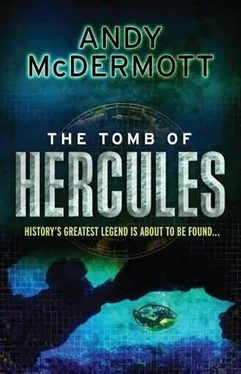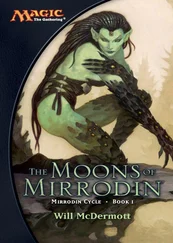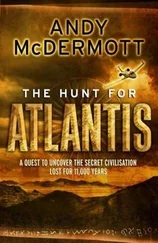
Andy McDermott
The Tomb Of Hercules
The second book in the Nina Wilde and Eddie Chase series, 2008
For my family and friends
PROLOGUE. The Gulf of Cádiz
One hundred miles off the southern coast of Portugal was hidden one of the greatest secrets in human history.
For now, it would remain hidden, guarded by another secret of much more recent origin.
Officially, the giant six-legged floating platform was listed as SBX- 2, a sea-based X-band radar station. Nicknamed the Taj Mahal for the huge white radar dome dominating its upper deck, the high-tech U.S. Navy behemoth swept the skies to the east for thousands of miles, its stated purpose to monitor North Africa and the Middle East for ballistic missile launches. In function and application, it was what it claimed to be.
But that was not the real reason for its presence. The truth lay eight hundred feet below.
Fifteen months earlier, the citadel at the heart of the lost civilization of Atlantis-long believed to be nothing more than a legend-had been discovered directly beneath where the SBX was now anchored. Though the only visible structure, the huge Temple of Poseidon, had been destroyed, radar surveys had revealed many more buried beneath the silt covering the seafloor. Since the discovery of Atlantis had ultimately turned out to be part of a conspiracy to exterminate three-quarters of humanity with a biological weapon, the Western governments that stepped in after the plot was foiled decided that not only the circumstances of the ancient city’s discovery, but also the mere fact of its existence should remain a secret. At least, until a more benign story of its finding could be concocted-and any danger of someone repeating the genocidal plan eliminated.
So while the SBX stood vigil over the skies, beneath it scientists and archaeologists explored the site in secrecy under the auspices of the International Heritage Agency, a United Nations organization established a year earlier with the mandate of locating and securing ancient sites such as Atlantis. The central leg on the starboard side of the giant radar platform had been converted into a submersible pen, a section of the pontoon at its base now open to the sea. Shielded by concrete walls six feet thick, the IHA scientists were normally able to conduct their explorations with no interference from the outside world.
But not tonight.
“Jesus,” muttered Bill Raynes, the IHA’s expedition director, clutching a handrail as the rig swayed again. The SBX was so massive and securely anchored that normally even an Atlantic storm did little more than gently rock it.
This was clearly a much bigger storm than usual.
One of the bright yellow two-man submersibles swung on its chains as it was winched out of the water. Raynes watched it anxiously. Its twin was already secured over the dock, but if conditions got much worse there was a danger that the loose sub could become an uncontrollable pendulum.
“Get a line on the damn thing!” he ordered. Two of his men hurried to obey, staggering around the edge of the moon pool as the floor lurched beneath them. They waited for the sub to swing back towards them, then snagged one of the chains with a boat hook, damping its motion. The dangerous swaying reduced, the winch operator raised the submersible fully into position above the dock, where more chains were quickly attached to secure it.
“Okay! Good work, guys,” Raynes called, letting out a relieved breath. Both subs were now safely in place, which meant the day’s operations were concluded. On most evenings, that would have been the cue for him to go up to the main deck and enjoy a cigar.
Not tonight, though. He wasn’t going to set one foot outdoors if he didn’t have to. He felt a brief stab of pity for the Marines stationed aboard the platform, who had guard duty no matter what the conditions. Poor bastards.
The unexpected weather aside, it had been a good day. The high-resolution sonar mapping of the citadel was ahead of schedule, and the excavation of the first site had already produced results, an exciting haul of Atlantean artifacts valuable in both historical and monetary terms. He may not have discovered Atlantis, but Raynes had already decided that he was damn well going to be the person famous for exploring it.
The actual discoverer of Atlantis was Dr. Nina Wilde, fifteen years Raynes’s junior and-on paper at least-his IHA superior. He wondered if the red-haired New Yorker had any idea that by accepting a senior post in the IHA she’d effectively ended her archaeological career before even turning thirty. Probably not, he decided. While she was certainly cute to look at, Nina also came across to Raynes as naive. It seemed to him that she’d been given the position of director of operations as a way to keep her-and her bodyguard-turned-boyfriend, Eddie Chase, whom Raynes regarded as little more than a sarcastic English thug-quiet and out of trouble while more experienced hands got on with the real work.
He made his way to the elevator cage running up the inside of the support leg, glancing at the dark void overhead. The SBX’s main deck, the size of two football fields, was twelve stories above sea level. Carrying the case of artifacts, Raynes slammed the gate closed and pushed the button to ascend.
Water sprayed up into the dock below as waves slapped noisily against the sides of the pool. He had never seen conditions inside the sub pen so bad before. Normally, the ocean surface inside the moon pool did little more than ripple. If it was this bad inside, he didn’t even want to think about what it would be like outside.
Spray blasted almost horizontally over the surface of the Atlantic, waves pounding explosively against the forward leg on the rig’s port side. The metal staircase that rose from the submerged pontoon to a ladder stretching up the towering structure rattled and moaned under the onslaught. It was not a place where anyone in his right mind would choose to be.
But someone was there.
The man was a giant, six feet eight inches tall, with every hard-packed muscle in his athlete’s body picked out by his skintight black wet suit. He emerged from the water and made his way up the stairs, hands clamping around the railings with the force of a vise, even the thunderous impact of the waves barely throwing him off his stride.
Once clear of the churning ocean, he paused to remove the scuba regulator from his mouth, revealing perfect white teeth-one inset with a diamond-surrounded by ebony skin, then began his climb up the ladder. Considering the distance and the conditions, most men would have been lucky to make it in under five minutes, and exhausted by the time they reached the top.
The intruder made it in two, and was breathing no more heavily than if he’d climbed a single flight of stairs.
Just below the top of the ladder, he stopped and carefully raised his head above the edge of the deck. The blocky gray superstructure of the SBX was three floors high, catwalks running along each level at the platform’s bow. Sickly yellow lights made a feeble attempt to illuminate them. Rain spattered on the man’s diving mask, obscuring his view. He frowned and pulled it from his face, revealing calculating black eyes before he flipped down another pair of goggles from the top of his head.
The weak yellow lights disappeared, replaced by shimmering blobs of video-game-vivid red and orange. Almost everything else was either blue or black. Ther-mographic vision, the world represented by the heat it gave off. The metal walls of the rig, lashed by freezing rain, were visible only as shades of blue.
Читать дальше













